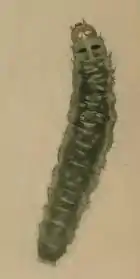| Epermenia falciformis | |
|---|---|
_Epermenia_falciformis_-_Flickr_-_Bennyboymothman.jpg.webp) | |
| Scientific classification | |
| Domain: | Eukaryota |
| Kingdom: | Animalia |
| Phylum: | Arthropoda |
| Class: | Insecta |
| Order: | Lepidoptera |
| Family: | Epermeniidae |
| Genus: | Epermenia |
| Species: | E. falciformis |
| Binomial name | |
| Epermenia falciformis | |
| Synonyms | |
| |
Epermenia falciformis, also known as the large lance-wing, is a moth of the family Epermeniidae found in Europe. It was first described by Adrian Hardy Haworth in 1828.
Description
The wingspan is 9–11 mm. Adults are on wing from June to July and again from August to September in two generations per year.[2]
Ova are laid on angelica (Angelica sylvestris) and ground-elder (Aegopodium podagraria) in June and July, and in the Autumn.[3] Larvae of the first generation feed in May and June in spun leaflets of their host plant, while larvae of the second generation mine a stem immediately below an umbel, causing it to droop and wither. When full grown, larvae leave via a small hole just before the junction above the main stem.[3] Pupation takes place in an open network cocoon amongst detritus on the ground.[4]
Distribution
It is found in Austria, Belgium, the Czech Republic, Denmark, France, Fennoscandia, Germany, Great Britain and Ireland, Latvia, the Netherlands and Slovakia.
References
- ↑ "Epermenia (Calotripis) falciformis (Haworth, 1828)". Fauna Europaea. Retrieved 4 October 2020.
- ↑ Kimber, Ian. "Epermenia falciformis (Haworth, 1828)". UKmoths. Retrieved 4 October 2020.
- 1 2 Godfray, H C J; Sterling, P H (1996). Epermeniidae. In Moths and Butterflies of Great Britain and Ireland. Volume 3. Colchester: Harley Books. pp. 119–20. ISBN 0-946589-56-9.
- ↑ "Lepidoptera of Belgium". Archived from the original on 2014-04-07. Retrieved 2011-10-24.

